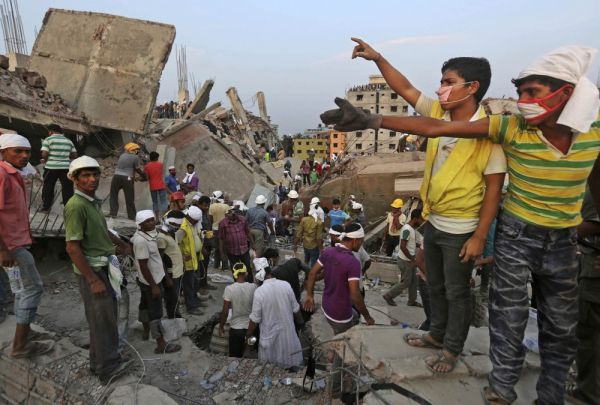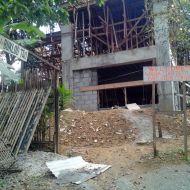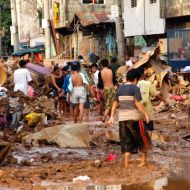Did Informal Construction Practices Play a Part in the Bangladesh Building Collapse?

As in many developing-world countries, construction in Bangladesh is typically a mix of formal and informal. Photo credit: AP
The horrific collapse of a garment factory in Bangladesh last week, killing at least 377 people, immediately called to mind last year’s shopping center collapse in Accra. In that incident, on November 7, a multi-story building housing a branch of Melcom, a low-cost department store, crumbled to the ground, trapping 81 people in debris and killing 14.
Though international attention has surrounded the Bangladeshi disaster in part because of its scale and the involvement of high-profile American and European brands, the Accra collapse shares a number of commonalities. Shoddy construction materials, a poor foundation and lack of enforcement of building codes were blamed for the Accra tragedy, according to official reports. The owner, apparently, did not have a permit for the building, and it’s rumored that the store used its upper floors for storing heavy equipment, putting extra stress on the building’s supports.
Similarly, Bangladesh’s National Fire Service has said that “the Rana Plaza building violated codes, with the four upper floors having been constructed illegally without permits,” according to the New York Times. In Bangladesh, a fire in a different factory some five months earlier had elicited pledges from officials to more strictly enforce building codes. Likewise, after the Accra collapse, President John Mahama and Accra Mayor Alfred Vanderpuye both promised to improve regulation of Ghana’s fast-growing construction industry. Despite this, another building recently collapsed in Kumasi, Accra’s second most important city.
In Accra, as new highrises spring up seemingly overnight, a good deal of the new construction occurs beyond the reach of legal codes and official building standards. As we drove around the city last month during his first visit to Ghana, my father — whose qualifications as an architect admittedly begin and end with his obsession with the book How Buildings Collapse — kept up a running list of his observations of flawed construction projects, of which there are many. He pointed out cracks in concrete, inadequate supports, even a gap between a supporting column and the floor it was supposed to support. A drive around Accra reveals hundreds of such works-in-progress, and a view from any tall building shows a skyline strewn with construction cranes.
Of course, it’s not just my father who’s noticed the problem. Everyone from government officials to professional associations to the man on the street is aware of the issue of poor construction in Accra. So the question becomes, Why? What – and who – is to blame? And how does informality factor into the city’s construction troubles?
One issue is a commonsense response to expensive land prices that factors into future growth. “_Asase wo wiem_” is a phrase used in Ghana that translates to, “There is land in the sky.” Land is at a premium in Accra right now, thanks to an oil-fueled construction boom, and securing ownership is difficult and complex as traditional land tenure systems conflict with the modern state system. So, people tend to build up – families building private homes expect to build extra floors onto those homes as money becomes available for construction and the family expands. The foundations that these houses are built on, however, typically are not designed for the extra load. So many homes may not meet formal standards, even as they meet a very real need in a growing city with a shortage of affordable housing.
Also at issue are informal systems that circumvent legal codes. Bribery is widely accepted in Accra – frankly, it’s a rational solution to a frustrating permitting process that takes, on average, six to nine months, according to a report by the Ghana Institute of Architects. And even when there’s no bribery and a permit is obtained, construction may not adhere to officially approved standards. For example, a building permitted for three stories may somehow end up being five stories tall.
There is a common perception, too, that consulting architects and engineers is an unnecessary expense and that building a house is a fairly simple and straightforward matter of stacking cement blocks. To save money, construction materials are often assembled on-site with little oversight. In a BBC report on the Melcom disaster, Magnus Quarshie of the Ghana Institute of Engineers criticized the concrete mix as not meeting specifications, saying that “the workmanship was very, very poor.”
A final issue is the training received by construction laborers, who largely operate informally as subcontractors. I’ve been told that most masons learn their trade through apprenticeships, first watching their masters and then working alongside them before starting their own businesses or freelancing. In neighboring Togo, on the other hand, construction workers go through formal training programs; Togolese masons in Ghana are preferred by many people concerned with construction quality. Furthermore, with so much new construction, I have to wonder if an informal training system that functioned well in the past is now being outpaced. Are informal-sector laborers without adequate training taking jobs simply because there are so many opportunities there?
Aspects of informality almost certainly play a part in disasters like Melcom, especially when professional standards are skirted not only by builders, but also by those overseeing construction. But Accra’s informal realm also played another, more positive role on the day of the Melcom disaster. The first responders to the collapse were not government agencies, but local informal workers. While formal emergency services reportedly faced the typical delays in responding to the incident, in those critical early minutes, it was traders and street vendors digging through the rubble, using only their hands and basic tools. In Accra, as in many other developing-world cities, when it comes to disaster relief, informal response systems can mean the difference between life and death.






